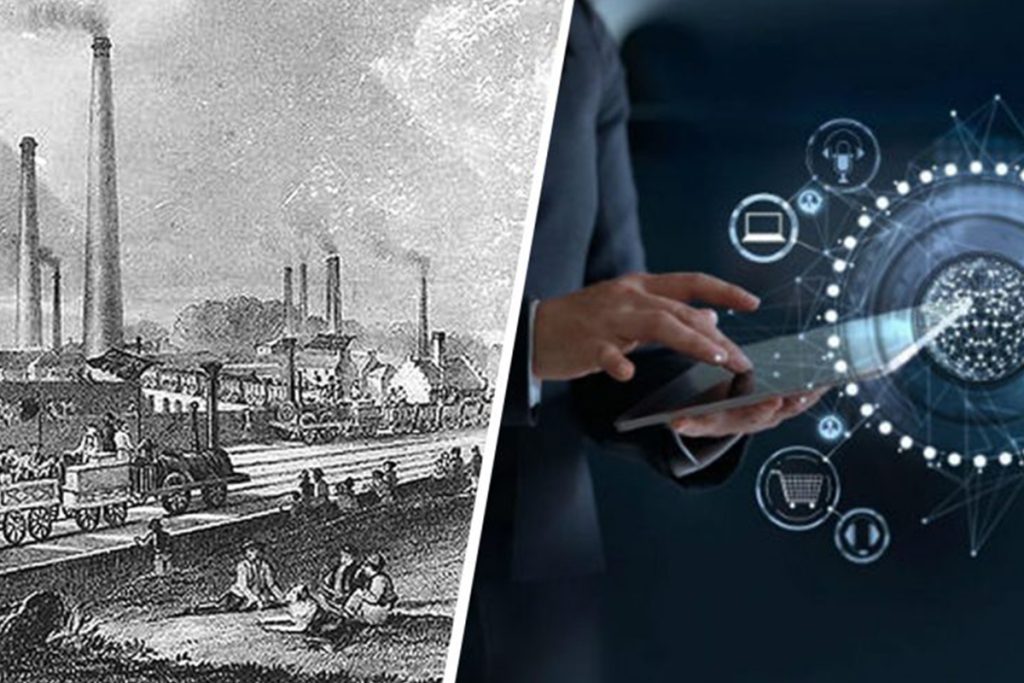In this final part of the blog, we will look at the factors that made banking the behemoth it is today – industrial revolution, globalization, and the rise of technology.
The industrial revolution and globalization
In the early 18th century, as agriculture stepped aside to bring industrial revolution in the spotlight, the need for capital increased further.
We can forever argue on what factors caused the growth of Industrial revolution in England, but from 1750, which is normally seen as the starting date of industrialization, the growth of the banking industry and the industrial revolution became entangled.
Before 1750, the economy was run on not just cash, but on gold, copper and other metals. After 1750, the entrepreneurs of England, Belgium, Germany, and France among other nations required not only an easy form of money, especially up front, but also needed an effective and efficient mechanism for their day to day transactions. Credit was also becoming a norm.
The traditional money lender could not provide this. Moreover, as pointed out earlier, the rise of Protestantism had created a new set of bankers – the Christian family bankers. Both these factors created an increase in demand for the banking industry and led to the rise of specialist banks with the knowledge of certain industries.
For example, in England, in 1750, there were three tiers of banks – the Bank of England was the first tier, the private banks, which were around thirty, formed the second tier and the local regional banks formed the third tier. By 1800, the number of private banks had increased to seventy and the number of regional banks doubled in 25 years.
The same story was repeated in countries like Belgium, Germany, and Italy.
In Belgium, the first country to follow England in the Industrial Revolution, banks such as Société Générale and Banque de Belgique became universal banks and where their growth was critical in the growth on Industrial Revolution in Belgium.
Germany is often cited as the best example of bank-driven development. Germany experienced rapid industrialization between 1850 and 1880 and the German Industrial Credit Banks played a critical role in this growth. The major banking players in Germany also witnessed an increase in their profits and more players stepped in. Between 1850 and 1870, 259 firms were incorporated as credit banks and most of these banks were profitable.
Italy, which witnessed a rapid surge in industrialization between 1890 and the first world war, also followed a similar path and the banking industry also grew rapidly.
While the banks in Europe focused on providing short-term loans, the banks in the US during these times focused on long-term loans. This led to the formation of a new form of banks – the investment banks. The US witnessed the rise of large investment banks who participated in the industrial growth in the latter part of the 19th century. Large scale projects were majorly financed by these investment banks in the US.
Two global wars and the world’s greatest depression followed the period of rapid industrialization.
Globalization followed world wars. The World Bank and the IMF were established. Banks acted as the catalysts for the modern society and the national banks grew beyond their national boundaries. Economies and banks became interconnected. Some followed a local strategy, some followed a global strategy, and some followed a truly glocal strategy.
Banking activities expanded in three phases – the first phase, which ran through the 1960s, was characterized by the euro-dollar market expansion which brought into limelight several European banks; the second phase, which happened during the 1970s, brought forth the importance of the Middle East through the rise of the oil economy and the third phase, which happened in the 1980s, was characterized by financial globalization, brought to the fore the US investment banks, the English merchant banks, and the Japanese banks.
The three phases not only helped banks expand but also forced banks to adopt new strategies. Many banks merged, some collapsed, but many new banks and financial institutions were born. Perhaps, the seeds of the financial crisis of 2007-08 were sown in these times as banks, which were driven by the need for greater and continued profits, started to follow riskier business models. It is interesting to think whether the financial crisis would have happened if the banks had not passed through any one of these stages. Hindsight is indeed a great teacher.
In the later stages of globalization, as the prevalence of technology increased in the banking industry, new kinds of banks emerged; countries fought with each other, not through weapons, but through economic policies driven by their central banks; competition increased between banks which meant that there was pressure on CEOs to adopt far riskier propositions to win a greater market share and increase profits and regulation, controls and compliance standards increased across the globe.
And one day, the Titanic hit the iceberg. 2008 happened.
In the US alone, 465 banks collapsed from 2008 to 2012. This fact alone is enough to showcase the impact of globalization on banking.
Perhaps, no other sector was impacted by the industrial revolution and globalization than the banking industry. The cornerstone of the modern economy is capitalism. Capitalism drove the two forces – industrial revolution and globalization and as noted before, banks were the circulatory system for capitalism.
From 1750, as the world transformed radically due to these two forces, the banking industry also grew. These two forces also resulted in the creation of another revolution which has catapulted the banking industry to the next level.
The rise of technology
Today, Amazon processes millions of transactions every year. Billions of dollars are spent on online shopping. It is hard to imagine that three decades ago, the idea of shopping through a hand-held device, was not just a dream, but out of the imagination of 99.99% of people across the world.
The world before 1750 was further different from what it was three decades ago. Speed was associated with horses, the difference engine invented by Charles Babbage was more than 70 years away, no one expected a message to be sent across from Europe to the US in a day and the Australian continent was not discovered by the Europeans.
But, with the birth of the Industrial Revolution, another wheel was also set in motion.
When Thomas Malthus observed in his Malthusian theory in 1798 that population would rise to such a level that the resources of the world would be insufficient, and this could lead a catastrophe, he had forgotten to accommodate the biggest thing had driven humanity till then – the human ingenuity and the increase in productivity per resource.
The wheel that was set in motion with the birth of the Industrial Revolution was the wheel of technology which built on the continuous urge for humans to produce more with the same set of resources and to find newer ways to do it.
As entrepreneurs focused on increasing profits, one thing became clear. Without the application of science, the productivity of resources can’t be increased and without increased productivity, profits cannot be increased. Technology can be defined as the application of science for practical purposes, and that is what the industrial revolution and later globalization did.
So, technology in banking did not start with internet banking or mobile banking. It started much before.
Probably, Western Union, who pioneered the concept of e-money in 1860 and electronically transferred e-money in 1871 through telegram were the earliest adopters of technology in banking.
But, the use of technology slowed down in the next forty years only to be revived by the bank’s move to automate many of its operational activities through technology. This was done by the increase in their scale of operations and the need to reduce operational costs.
The era after the second world war saw an increased focus on technology. This was driven primarily by the enormous benefits that banks foresaw from leveraging the technology invented for the world war.
The first credit card, which was a precursor to the Diners card was invented by John Biggins in 1946. It was called Charge-It.
Banks started to invest heavily in computers from the 1950s. In fact, many large banks brought mainframe computers to process a large set of transactions. In 1957, the CNEP, one of the four banks that merged to form BNP, bought Bull Gamma 60, the largest computer in Europe at that time. In the late 1950s, the Magnetic Ink Character Recognition or MICR was introduced propelling the way forward for cheques to be cleared faster.
1967 was a truly ground-breaking year for banks and technology as Barclays introduced the first ATM, a revolutionary piece of technology that propelled access to cash and access to banks further. Now, a bank at every block was a possibility.
1980 saw the bank coming to us through another channel as telephone banking was introduced. I am sure most of you would appreciate the benefits of phone banking.
Around the mid-1990s, some intelligent people working in a bank saw the possibility of the internet for expanding their operations and gradually, all the banks embraced this new wonder-kid with open arms. And the rest they say is history.
Today, with blockchain, big data analytics, artificial intelligence, and many more technological innovations, banks are far from the dull data storing dust-filled offices they were in the early 80s or 90s.
Globalization created a need for banks to reach out to a large set of the market in a relatively short frame of time. Banks used technology to cover this distance in an exponential way. If the industrial revolution and globalization were the airplanes on which the banking industry rode, then technology is now the rocket on which the banking industry is riding. Technology has not only enabled banking to become more efficient and reach new markets, but also helped in the creation of new models, new products, new services, and even new organizations.
The bank of today is a result of all these forces. In hindsight, even if one of these forces was not there, the banks of today would have looked differently. What if the computer was not invented? What if printing was not accepted? What if the British empire was not allowed to grow? What if the industrial revolution had not happened?
These forces were not just causal forces, but these forces were also further shaped by the banking industry. We may call these forces and the banking industry cyclical friends – A shapes B and B further shape A in return.
None of these forces were planned but were the result of how humanity progressed. Perhaps the single biggest shapers of the banking industry have been the evolution of humans and their tenacity to succeed.












